Here, I will introduce the items needed to properly learn Tenshin-ryu. While many items are required, it can be difficult to have everything prepared from the beginning. Therefore, I will first introduce the ideal items to have as a basic foundation. Next, I will present the items necessary for deeper study. Finally, I will guide you on what items you should gradually gather, starting with the essentials, and how to practice along the way.
Katana (Sword)

Whether using a real sword (Shinken 真剣) or an imitation (Mozotô 模造刀), it’s not a problem. However, for beginners, it can be dangerous, so if using a real sword, please exercise caution. Additionally, it is safer to use a real sword with a dull edge (known as a “Habiki 刃引き“, where the blade is made blunt to prevent cutting).
Keep in mind that inexpensive swords carry a risk of the blade breaking or the handle being damaged. Typically, both real and imitation swords are fixed with a mekugi 目釘, a small bamboo peg, which secures the handle to the blade. If this peg comes loose or breaks, the blade can detach while swinging the sword, potentially injuring someone or causing damage to objects.
There have been fatal accidents during Iaido and kenjutsu practice. (Fortunately, there have been no accidents within Tenshin-ryu, but it is not surprising if one were to occur at any time.)
Therefore, always check the mekugi before every practice session to maintain safety. Treat your sword with care and always observe it closely, just as you would love and care for your own weapon.
Samurai carried both a long sword (Daitô 大刀) and a short sword (Shôtô 小刀 or Wakizashi 脇指) at all times. In Tenshinryu, you need to learn techniques that involve both swords, so both are required.
Bokken (Bokutô)
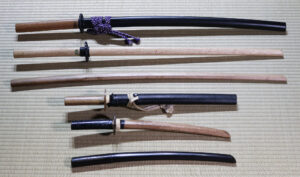
Bokken 木剣 (The general term is “bokken 木剣“) is a sword made of wood (For this reason, it is sometimes called a “wooden sword” overseas). It is used not only for kenjutsu 剣術 (swordmanship) practice but also for battôjutsu 抜刀術 (drawing the sword technique).
In Tenshinryu, beginners traditionally use a wooden sword for practice. This practice involves using the left hand as a substitute for the Saya 鞘(scabbard), and it is called Tezaya 手鞘. “Te” means hand, and “Zaya” is a voiced form of “Saya“, which originally means scabbard. Therefore, it refers to using the hand as the scabbard.
If possible, please prepare a type with a guard (tsuba 鍔) and a scabbard (saya).
Kakuobi
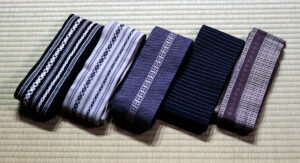
The kaku-obi 角帯 is a type of belt worn by men during the Edo period. To carry two swords, a kaku obi approximately 4 meters long and 10 cm wide is required. If your waist is larger, you may need a longer kaku obi.
This belt is made of cotton (Men 綿) or silk (Kinu 絹 or Shôken 正絹), but for practice, cotton is recommended because it is inexpensive and easy to wash and care for. While cotton may be a bit slippery, making it easier for the swords to become unstable, synthetic materials (Kasen 化繊) can also be used.
As an alternative, you can use the belts typically worn in judo, jujutsu, karate, or the iaid-obi, which is a belt specifically for iaido. However, in both cases, when carrying two swords, the swords become very unstable.
Keikogi
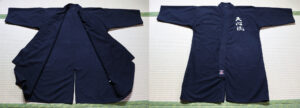
Overseas, it is commonly referred to as “Gi”, but this is incorrect Japanese and is not understood in Japan. The term “Gi” comes from the keiko 稽古 (lesson) and kimono 着物 (clothing), where the “Ki” becomes voiced, resulting in “gi”. The term “Gi” is only used in this form overseas, and it is unnatural in Japanese.
A regular kimono or yukata 浴衣 can be used as an alternative. Additionally, since the hakama 袴 (wide-legged pants) is more important, it might be a good idea to purchase the hakama first.
In the Edo period, aside from jujutsu and similar arts, people used worn-out regular kimonos for practice, and there were no special training kimonos sold. Many schools that have altered traditional practices in modern times treat practice clothes as a uniform to be revered, but this is an incorrect tradition.
Of course, treating objects with care is an important aspect of Japanese traditional spirit, but they are tools for practice, not objects of faith. Unfortunately, there are many people, even within Japan, who have become influenced by this incorrect mindset, so please be cautious.
Hakama
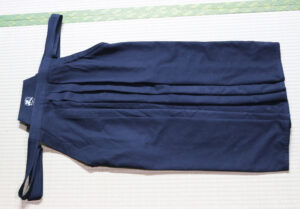
The hakama 袴 was worn exclusively by samurai during the Edo period, as they were the only class permitted (Among the four social classes—samurai, farmers, artisans, and merchants. These four classes are collectively referred to as shi nô kô shô 士農工商)—only samurai were allowed to wear the hakama.) to wear it, making it one of the symbols of the samurai. When carrying two swords, the hakama’s ties help secure the swords, making them more stable and allowing for easier movement.
Of course, it is possible to carry two swords without wearing the hakama, but it would be a bit unstable.
There are two types of hakama: the andon bakama 行灯袴, which is like a skirt and does not have a split at the crotch, and the umanori bakama 馬乗り袴, which is split like pants for riding. However, samurai generally used the umanori baakama, so please be sure to purchase this type.
In modern kendo and other martial arts, most people wear the obi and hakama in positions different from those in the past. Therefore, if you follow the standards of many stores, you may end up purchasing a hakama that is too long. Measure the distance from your hip bone to your ankle, and buy a hakama where the length from the front ties to the hem matches this measurement.
In the West, people typically wear pants and other garments around the waist, at the waistline. However, when wearing the hakama and obi, they should be worn slightly lower, around the hip bone. This is the correct position, which allows for proper kimono dressing and also ensures that both the long and short swords can be properly worn.
Even in modern Japan, the tradition of wearing a kimono correctly from a young age is nearly nonexistent. Since the Meiji period, the practice of wearing a kimono in the Western-style position became popular, and today, many people still wear the hakama incorrectly.
Sensu (Ogi)

The sensu 扇子 (folding fan. It is also called a Ôgi 扇) was an essential item that samurai carried year-round, regardless of the season. In the society of the time, only samurai were permitted to carry a kawahori sensu かわほり扇子 蝙蝠扇子 (a fan of the same size as a military fan-Gunsen 軍扇, 12 inches in length). Because of this, the kawahori sensu became a symbol of the samurai class, and in Tenshin-ryu, it is used during demonstrations and training.
However, due to the high cost of the kawahori sensu, a smaller version, commonly referred to as a maisen 舞扇(used for Japanese dance), is typically used in practice. (Even in the Edo period, samurai did not exclusively use the kawahori sensu.)
This fan was not only used to cool off in summer but also served a wide range of purposes, such as hiding one’s face, giving instructions, replacing a tray, or even as a weapon for self-defense. It had many uses among samurai. In Tenshin-ryu, we carry this traditional, essential item during practice as well.
Tabi

Tabi 足袋 are the Japanese version of socks. However, cotton tabi only became widespread after the middle Edo period, and samurai typically did not wear them except on special occasions. (There is a historical record from the Edo period where a samurai, due to old age and the cold winter inside the castle, submitted a request and was granted permission to wear them.)
Tenshin-ryu training at Shirindan was primarily conducted barefoot. However, due to the cold in winter, as well as to prevent friction on the soles of the feet and reduce the risk of injury from stepping on sharp objects or debris, tabi are typically worn during training in modern times.
In Japan, particularly because of the high humidity, foot fungus (athlete’s foot) became widespread, and it was once one of the country’s common ailments. For hygiene reasons, and to prevent foot odor, wearing tabi is recommended in modern times.
However, tabi can sometimes be slippery and may interfere with footwork, so it is also ideal to occasionally practice barefoot to maintain balance and foot movement.
knee supporters
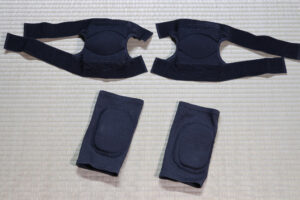
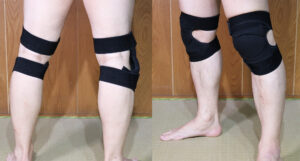
Although they were not used in the Edo period, the use of knee supporters is recommended in modern times. This is important not only for protecting the knee joints but also for preventing darkening of the skin on the knees. In the past, knee calluses were considered a sign of being a skilled practitioner, but today, due to the long-term nature of training, the fact that floor-seating lifestyles are no longer common, and the occasional need to practice on floors harder than wooden floors, knee supporters are used.
The knee supporters can be of the same type used in general sports. When training for extended periods, it is recommended to use those with gaps behind the knees to prevent hindering movement and to allow for better ventilation, preventing sweating and discomfort.
Gradually Required Items
In addition, Tenshin-ryu requires various practice items such as the marudachi 丸太刀, which is a bamboo stick with a leather cover (Commonly called Fukurojinai 袋竹刀), as well as tachi koshirae 太刀拵え (The sword fittings from the old era before the Edo period. In contrast to the uchigatana koshirae, where the sword is directly worn on the belt, the tachikosirae style involved tying the cord attached to the scabbard around the waist and suspending the tachi (long sword) from it. This style of sword fittings is called tachikosirae.), nobakama 野袴 (wide-legged pants with tapered hems), Tessa 手鎖 (A weapon with weights attached to both ends of a chain), kusarigama 鎖鎌 (chain and sickle), Suyari 素槍 (spears), Jûmonji yari 十文字槍(cross-shaped spear), Naginata 薙刀, and shuriken 手裏剣, etc .
Additionally, if you can prepare items used in the past, such as Tabimakura 旅枕 (Portable foldable pillow for travel), Hakomakura 箱枕 (box pillows), Kyôsoku 脇息 (armrests), Syokudai 燭台 (candlesticks), and Chochin 提灯 (lanterns), it would create an ideal practice environment. (These items are also used during practice.)
Furthermore, in daily life, it is important to practice wearing traditional clothing and incorporate aspects of the past into your routine. By doing so, the martial arts rooted in the lifestyle and habits of the past will naturally seep into both your mind and body, leading to inevitable improvement.
Order of Acquisition and Training
If you are able to purchase all the items mentioned earlier without issue, there is no problem. However, for those who need to acquire them gradually due to financial reasons, the following order of acquisition would be beneficial:
Wooden Sword (Bokken) for the Long Sword
First and foremost, this is all you need to begin training. With this, you can practice drawing the sword by using your left hand as a stand-in for the scabbard. You can also practice zaho okigatana training, as well as swordsmanship.
Kaku Obi (Obi for Carrying the Sword)
The next step is the kaku obi. With this, you can learn how to tie the obi properly and practice wearing the wooden sword. While it is not a complete replacement for the proper scabbard, it will help you simulate the drawing of the sword and create a situation similar to that of drawing from a scabbard.
During the Edo period, Tenshin-ryu would sometimes use bamboo carved out to substitute for the scabbard. This was not a full scabbard but a section that extended from the koiguchi 鯉口 (mouth of the scabbard) to the kurikata 栗形 (A protrusion through which the string Sageo 下緒 attached to the sheath passes) length. In modern times, a simple solution is to insert the wooden sword into a tube, like a roll of plastic wrap, which serves as a sufficient substitute for the scabbard.
Hakama
The next item is the hakama. Wearing the hakama is challenging in itself, and it also adds complexity to footwork and sword drawing. Therefore, it is best to acquire the hakama as early as possible and practice wearing it during sword training.
Wooden Sword for the Short Sword
If you can obtain a wooden sword for the short sword, you will be able to practice the signature technique of Tenshin-ryu—carrying two swords. With the kaku obi and hakama in place, you can also learn proper Titô (sword-wearing methods) and practice correct drawing techniques.
The items introduced here are just one example. It is perfectly fine if the order of acquisition changes based on your financial situation or personal preferences. Imitation swords are, of course, important for more serious training and, most importantly, they serve as a great motivator for your practice. If you choose to purchase an imitation sword instead of a wooden sword, there is no problem with that.


コメント